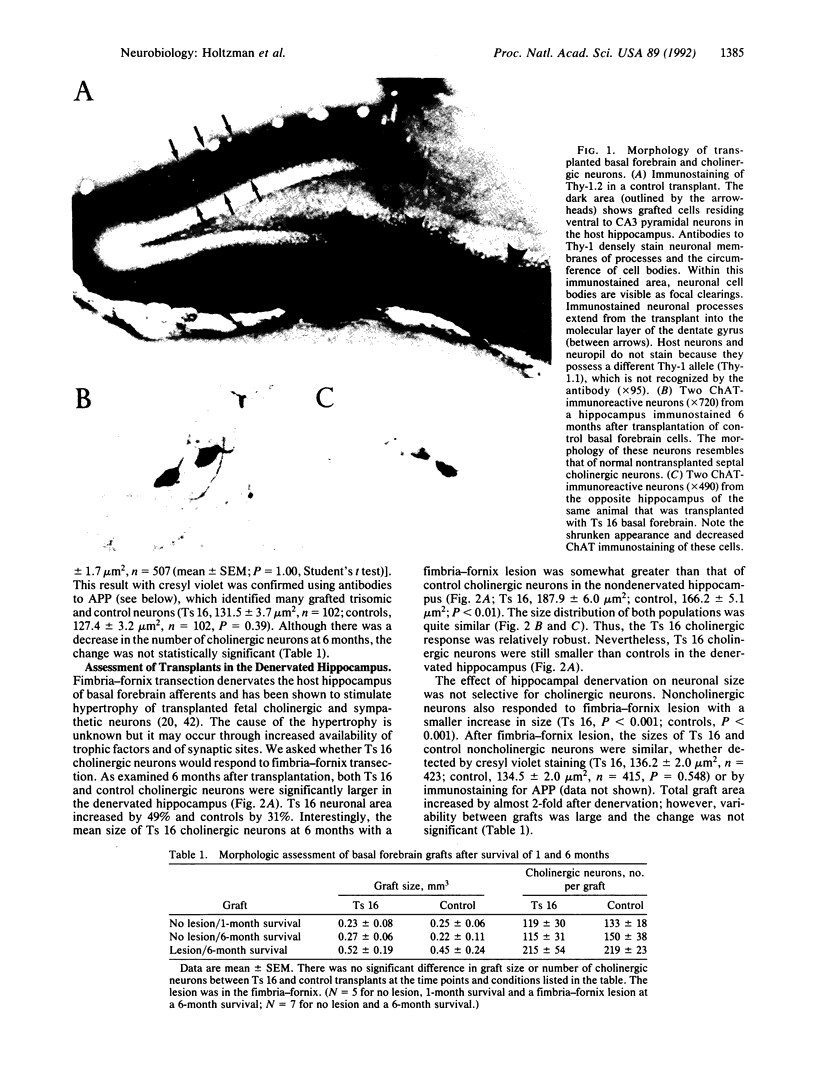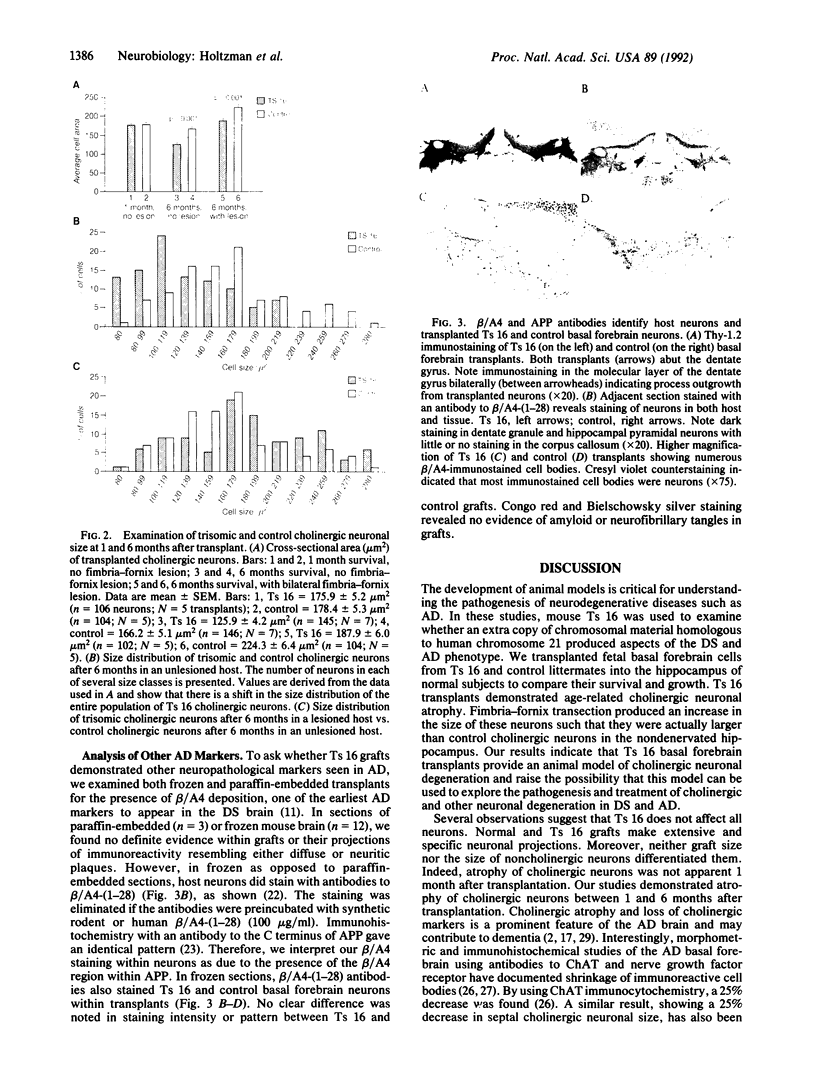Abstract
Vulnerability of specific brain regions and neuronal populations is a characteristic feature of Alzheimer disease and Down syndrome. Cholinergic neurons of the basal forebrain degenerate in both disorders. The basis for neuronal degeneration is unknown. Mouse trisomy 16 (Ts 16) is an animal model of Down syndrome. We sought an experimental system in which the survival and development of Ts 16 basal forebrain cholinergic neurons could be examined beyond the fetal period. As Ts 16 mice do not survive birth, we transplanted fetal Ts 16 and control basal forebrain into the hippocampus of young adult mice. Transplanted neurons survived and grew neurites in all grafts. Over time, we observed selective atrophy of cholinergic neurons in Ts 16 grafts. Denervation of the hippocampus produced a significant increase in the size of Ts 16 cholinergic neurons. This suggests that hippocampal-derived neurotrophic factors acted to prevent degeneration. beta/A4-amyloid-containing plaques were not seen. Ts 16 provides a model of spontaneous, genetically determined neurodegeneration that may be used to understand better the molecular pathogenesis of neuronal dysfunction in Alzheimer disease and Down syndrome.
Full text
PDF




Images in this article
Selected References
These references are in PubMed. This may not be the complete list of references from this article.
- Alderson R. F., Alterman A. L., Barde Y. A., Lindsay R. M. Brain-derived neurotrophic factor increases survival and differentiated functions of rat septal cholinergic neurons in culture. Neuron. 1990 Sep;5(3):297–306. doi: 10.1016/0896-6273(90)90166-d. [DOI] [PubMed] [Google Scholar]
- Card J. P., Meade R. P., Davis L. G. Immunocytochemical localization of the precursor protein for beta-amyloid in the rat central nervous system. Neuron. 1988 Nov;1(9):835–846. doi: 10.1016/0896-6273(88)90131-6. [DOI] [PubMed] [Google Scholar]
- Casanova M. F., Walker L. C., Whitehouse P. J., Price D. L. Abnormalities of the nucleus basalis in Down's syndrome. Ann Neurol. 1985 Sep;18(3):310–313. doi: 10.1002/ana.410180306. [DOI] [PubMed] [Google Scholar]
- Cheng S. V., Nadeau J. H., Tanzi R. E., Watkins P. C., Jagadesh J., Taylor B. A., Haines J. L., Sacchi N., Gusella J. F. Comparative mapping of DNA markers from the familial Alzheimer disease and Down syndrome regions of human chromosome 21 to mouse chromosomes 16 and 17. Proc Natl Acad Sci U S A. 1988 Aug;85(16):6032–6036. doi: 10.1073/pnas.85.16.6032. [DOI] [PMC free article] [PubMed] [Google Scholar]
- Corsi P., Coyle J. T. Nerve growth factor corrects developmental impairments of basal forebrain cholinergic neurons in the trisomy 16 mouse. Proc Natl Acad Sci U S A. 1991 Mar 1;88(5):1793–1797. doi: 10.1073/pnas.88.5.1793. [DOI] [PMC free article] [PubMed] [Google Scholar]
- Cox D. R., Smith S. A., Epstein L. B., Epstein C. J. Mouse trisomy 16 as an animal model of human trisomy 21 (Down syndrome): production of viable trisomy 16 diploid mouse chimeras. Dev Biol. 1984 Feb;101(2):416–424. doi: 10.1016/0012-1606(84)90156-8. [DOI] [PubMed] [Google Scholar]
- Coyle J. T., Oster-Granite M. L., Reeves R. H., Gearhart J. D. Down syndrome, Alzheimer's disease and the trisomy 16 mouse. Trends Neurosci. 1988 Sep;11(9):390–394. doi: 10.1016/0166-2236(88)90075-6. [DOI] [PubMed] [Google Scholar]
- Coyle J. T., Price D. L., DeLong M. R. Alzheimer's disease: a disorder of cortical cholinergic innervation. Science. 1983 Mar 11;219(4589):1184–1190. doi: 10.1126/science.6338589. [DOI] [PubMed] [Google Scholar]
- Fischer W., Wictorin K., Björklund A., Williams L. R., Varon S., Gage F. H. Amelioration of cholinergic neuron atrophy and spatial memory impairment in aged rats by nerve growth factor. Nature. 1987 Sep 3;329(6134):65–68. doi: 10.1038/329065a0. [DOI] [PubMed] [Google Scholar]
- Gage F. H., Björklund A. Enhanced graft survival in the hippocampus following selective denervation. Neuroscience. 1986;17(1):89–98. doi: 10.1016/0306-4522(86)90227-7. [DOI] [PubMed] [Google Scholar]
- Gage F. H., Björklund A., Stenevi U. Denervation releases a neuronal survival factor in adult rat hippocampus. Nature. 1984 Apr 12;308(5960):637–639. doi: 10.1038/308637a0. [DOI] [PubMed] [Google Scholar]
- Glenner G. G., Wong C. W. Alzheimer's disease and Down's syndrome: sharing of a unique cerebrovascular amyloid fibril protein. Biochem Biophys Res Commun. 1984 Aug 16;122(3):1131–1135. doi: 10.1016/0006-291x(84)91209-9. [DOI] [PubMed] [Google Scholar]
- Hefti F. Nerve growth factor promotes survival of septal cholinergic neurons after fimbrial transections. J Neurosci. 1986 Aug;6(8):2155–2162. doi: 10.1523/JNEUROSCI.06-08-02155.1986. [DOI] [PMC free article] [PubMed] [Google Scholar]
- Holtzman D. M., Mobley W. C. Molecular studies in Alzheimer's disease. Trends Biochem Sci. 1991 Apr;16(4):140–144. doi: 10.1016/0968-0004(91)90056-2. [DOI] [PubMed] [Google Scholar]
- Katzman R. Alzheimer's disease. N Engl J Med. 1986 Apr 10;314(15):964–973. doi: 10.1056/NEJM198604103141506. [DOI] [PubMed] [Google Scholar]
- Kitt C. A., Price D. L., Struble R. G., Cork L. C., Wainer B. H., Becher M. W., Mobley W. C. Evidence for cholinergic neurites in senile plaques. Science. 1984 Dec 21;226(4681):1443–1445. doi: 10.1126/science.6505701. [DOI] [PubMed] [Google Scholar]
- Large T. H., Bodary S. C., Clegg D. O., Weskamp G., Otten U., Reichardt L. F. Nerve growth factor gene expression in the developing rat brain. Science. 1986 Oct 17;234(4774):352–355. doi: 10.1126/science.3764415. [DOI] [PubMed] [Google Scholar]
- Leibrock J., Lottspeich F., Hohn A., Hofer M., Hengerer B., Masiakowski P., Thoenen H., Barde Y. A. Molecular cloning and expression of brain-derived neurotrophic factor. Nature. 1989 Sep 14;341(6238):149–152. doi: 10.1038/341149a0. [DOI] [PubMed] [Google Scholar]
- Maisonpierre P. C., Belluscio L., Friedman B., Alderson R. F., Wiegand S. J., Furth M. E., Lindsay R. M., Yancopoulos G. D. NT-3, BDNF, and NGF in the developing rat nervous system: parallel as well as reciprocal patterns of expression. Neuron. 1990 Oct;5(4):501–509. doi: 10.1016/0896-6273(90)90089-x. [DOI] [PubMed] [Google Scholar]
- Masters C. L., Simms G., Weinman N. A., Multhaup G., McDonald B. L., Beyreuther K. Amyloid plaque core protein in Alzheimer disease and Down syndrome. Proc Natl Acad Sci U S A. 1985 Jun;82(12):4245–4249. doi: 10.1073/pnas.82.12.4245. [DOI] [PMC free article] [PubMed] [Google Scholar]
- Milner T. A., Loy R., Amaral D. G. An anatomical study of the development of the septo-hippocampal projection in the rat. Brain Res. 1983 Jun;284(2-3):343–371. doi: 10.1016/0165-3806(83)90017-2. [DOI] [PubMed] [Google Scholar]
- Pearson R. C., Sofroniew M. V., Cuello A. C., Powell T. P., Eckenstein F., Esiri M. M., Wilcock G. K. Persistence of cholinergic neurons in the basal nucleus in a brain with senile dementia of the Alzheimer's type demonstrated by immunohistochemical staining for choline acetyltransferase. Brain Res. 1983 Dec 19;289(1-2):375–379. doi: 10.1016/0006-8993(83)90046-x. [DOI] [PubMed] [Google Scholar]
- Perry E. K., Tomlinson B. E., Blessed G., Bergmann K., Gibson P. H., Perry R. H. Correlation of cholinergic abnormalities with senile plaques and mental test scores in senile dementia. Br Med J. 1978 Nov 25;2(6150):1457–1459. doi: 10.1136/bmj.2.6150.1457. [DOI] [PMC free article] [PubMed] [Google Scholar]
- Phillips H. S., Hains J. M., Laramee G. R., Rosenthal A., Winslow J. W. Widespread expression of BDNF but not NT3 by target areas of basal forebrain cholinergic neurons. Science. 1990 Oct 12;250(4978):290–294. doi: 10.1126/science.1688328. [DOI] [PubMed] [Google Scholar]
- Price D. L. New perspectives on Alzheimer's disease. Annu Rev Neurosci. 1986;9:489–512. doi: 10.1146/annurev.ne.09.030186.002421. [DOI] [PubMed] [Google Scholar]
- Quon D., Wang Y., Catalano R., Scardina J. M., Murakami K., Cordell B. Formation of beta-amyloid protein deposits in brains of transgenic mice. Nature. 1991 Jul 18;352(6332):239–241. doi: 10.1038/352239a0. [DOI] [PubMed] [Google Scholar]
- Rumble B., Retallack R., Hilbich C., Simms G., Multhaup G., Martins R., Hockey A., Montgomery P., Beyreuther K., Masters C. L. Amyloid A4 protein and its precursor in Down's syndrome and Alzheimer's disease. N Engl J Med. 1989 Jun 1;320(22):1446–1452. doi: 10.1056/NEJM198906013202203. [DOI] [PubMed] [Google Scholar]
- Selkoe D. J. Deciphering Alzheimer's disease: the amyloid precursor protein yields new clues. Science. 1990 Jun 1;248(4959):1058–1060. doi: 10.1126/science.2111582. [DOI] [PubMed] [Google Scholar]
- Siman R., Card J. P., Nelson R. B., Davis L. G. Expression of beta-amyloid precursor protein in reactive astrocytes following neuronal damage. Neuron. 1989 Sep;3(3):275–285. doi: 10.1016/0896-6273(89)90252-3. [DOI] [PubMed] [Google Scholar]
- Sweeney J. E., Höhmann C. F., Oster-Granite M. L., Coyle J. T. Neurogenesis of the basal forebrain in euploid and trisomy 16 mice: an animal model for developmental disorders in Down syndrome. Neuroscience. 1989;31(2):413–425. doi: 10.1016/0306-4522(89)90384-9. [DOI] [PubMed] [Google Scholar]
- Tanzi R. E., St George-Hyslop P. H., Gusella J. F. Molecular genetic approaches to Alzheimer's disease. Trends Neurosci. 1989 Apr;12(4):152–158. doi: 10.1016/0166-2236(89)90055-6. [DOI] [PubMed] [Google Scholar]
- Thal L. J., Mandel R. J., Terry R. D., Buzsaki G., Gage F. H. Nucleus basalis lesions fail to induce senile plaques in the rat. Exp Neurol. 1990 Apr;108(1):88–90. doi: 10.1016/0014-4886(90)90013-i. [DOI] [PubMed] [Google Scholar]
- Uylings H. B., van Eden C. G., Hofman M. A. Morphometry of size/volume variables and comparison of their bivariate relations in the nervous system under different conditions. J Neurosci Methods. 1986 Oct;18(1-2):19–37. doi: 10.1016/0165-0270(86)90111-1. [DOI] [PubMed] [Google Scholar]
- Vogels O. J., Broere C. A., ter Laak H. J., ten Donkelaar H. J., Nieuwenhuys R., Schulte B. P. Cell loss and shrinkage in the nucleus basalis Meynert complex in Alzheimer's disease. Neurobiol Aging. 1990 Jan-Feb;11(1):3–13. doi: 10.1016/0197-4580(90)90056-6. [DOI] [PubMed] [Google Scholar]
- Williams L. R., Varon S., Peterson G. M., Wictorin K., Fischer W., Bjorklund A., Gage F. H. Continuous infusion of nerve growth factor prevents basal forebrain neuronal death after fimbria fornix transection. Proc Natl Acad Sci U S A. 1986 Dec;83(23):9231–9235. doi: 10.1073/pnas.83.23.9231. [DOI] [PMC free article] [PubMed] [Google Scholar]
- Wisniewski K. E., Wisniewski H. M., Wen G. Y. Occurrence of neuropathological changes and dementia of Alzheimer's disease in Down's syndrome. Ann Neurol. 1985 Mar;17(3):278–282. doi: 10.1002/ana.410170310. [DOI] [PubMed] [Google Scholar]
- Zhou C. F., Raisman G., Morris R. J. Specific patterns of fibre outgrowth from transplants to host mice hippocampi, shown immunohistochemically by the use of allelic forms of Thy-1. Neuroscience. 1985 Dec;16(4):819–833. doi: 10.1016/0306-4522(85)90096-x. [DOI] [PubMed] [Google Scholar]







